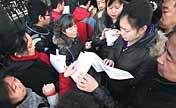
The same problems occurred in many other developed countries, like the United States, Japan and Britain during their industrialization, said Wang Ming, a member of the National Committee of the Chinese People's Political Consultative Conference, the country's top political advisory body.
Urban problems
China's rapid development has caused urban problems that have become increasingly worrisome, said Wang, adding the country has more than 10 megacities now. In fact, a policy of controlling the scale of large cities, developing appropriately sized, medium cities and actively building small ones was put forward as early as 1980.
But the main tool in the past was the household registration system, or hukou, which ties benefits such as education and medical care, to place of registered residence - not cities where people migrate. The hukou has proved problematic, said Dong Liming, a professor of urban and environment research at Peking University.
Legislation is needed to avoid the concentration of urban facilities and functions, according to Pan.
Large cities should focus on high value-added industries such as high-tech and cultural sectors, whereas small and medium-sized cities and small towns develop their distinctive industries, Pan said.
Beijing, for example, is working hard to accelerate the transformation of its economic growth mode and explore the control of the city's scale and slow population growth, said Beijing Mayor Wang Anshun.
The population of Beijing grew from 16.3 million in early 2008 to 20.6 million currently and is increasing by about 600,000 annually. Beijing covers around 16,800 sq km. Business hub Shanghai, which covers 6,340 sq km, has about 24 million people.
Comprehensive measures should be adopted to control the size of megacities and large cities and new ones should try to avoid the way current megacities have expanded, according to analysts.
"A big population is not necessarily good for a city. What is important is that a city should have its own distinctive features and is livable," said Pan.
According to an urban development report issued by the Chinese Academy of Social Sciences last year, the next five to 10ten years is a key period for China's urbanization drive.
Large cities face challenges in economic structure, planning, construction, management, environment and public services, said the report. It is a must to underline the scientific development of cities and enhance the quality of urbanization, the report said.
The authors are Xinhua writers.



















![]()
